July 15, 2022
Air Date: July 15, 2022
FULL SHOW
SEGMENTS

Defense Production Act for Domestic Solar
View the page for this story
President Biden invoked the Defense Production Act to stimulate domestic production of clean energy technology including solar panels and heat pumps. Congressman Mike Levin from California joins Host Steve Curwood for details. (08:50)

Beyond the Headlines
/ Peter DykstraView the page for this story
Environmental Health News editor Peter Dykstra joins host Steve Curwood to discuss the growing investment potential for plant-based meat. They also take a look at the increasing temperatures and heat waves rolling through Europe. And from history books, a look at some of the controversy surrounding the Bureau of Land Management since it was established 76 years ago. (04:33)
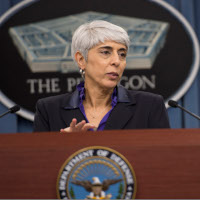
New Science Advisor Arati Prabhakar
/ Jenni DoeningView the page for this story
President Biden has nominated, Arati Prabhakar to the cabinet level position of White House Science Advisor. If confirmed by the Senate, she would become the first woman, person of color and immigrant to hold the job. Seth Borenstein, a science writer at The Associated Press, joins Host Jenni Doering for details on the historic nomination. (08:14)
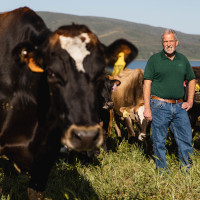
Feeding Seaweed to Cows for Lower Emissions
View the page for this story
Roughly one third of US methane emissions comes from livestock, mostly cattle. Albert Straus of Straus Family Creamery joins host Bobby Bascomb to talk about how he reduced methane emissions on his farm by participating in a trial experiment to feeding a seaweed supplement to his cows. (08:06)

BirdNote®: Brewer’s Sparrow, Sageland Singer
/ Mary McCannView the page for this story
One of the most musical and complex bird songs in the US is that of the Brewer's Sparrow. It's a veritable aria, ringing out from the sagebrush of Eastern Washington's Columbia Basin. BirdNote®’s Mary McCann has more about this sageland singer. (01:55)
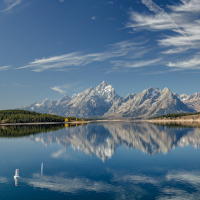
Grand Teton and Wild Weather Out West
View the page for this story
High temperatures in the West accelerated glacial melt leading to the floods and mudslides that forced Yellowstone National Park to temporarily close this summer. David Titley, former Oceanographer and Navigator of the Navy and former Chief Operating Officer for NOAA, joins Host Steve Curwood to discuss how climate change is disrupting the greater Yellowstone area from his home in Grand Teton National Park. (15:36)
Show Credits and Funders
Show Transcript
[THEME]
CURWOOD: From PRX – this is Living On Earth.
[THEME]
CURWOOD: I’m Steve Curwood.
President Biden invokes the Defense Production Act to boost domestic solar and other clean energy tech.
LEVIN: We’re gonna transition to a clean energy economy in the United States and around the world. I believe the old Wayne Gretsky quote, you know the hockey player, where he says skate to where the puck is going to be, not to where the puck is. And we know where the energy economy is going to be 20, 30 years from now and it’s all renewables.
CURWOOD: Also, the charms of Grand Teton National Park in Wyoming.
TITLEY: It's really, you know, Nirvana if you will for recreation. We have wide open spaces that are really just sagebrush and that lets visitors when we have animals out on those flats be able to see those animals as opposed to some of the other parks where you have so many trees you don't always get those kinds of views.
CURWOOD: That and more this week on Living on Earth – Stick Around!
[NEWSBREAK MUSIC: Boards Of Canada “Zoetrope” from “In A Beautiful Place Out In The Country” (Warp Records 2000)]
[THEME]
Defense Production Act for Domestic Solar
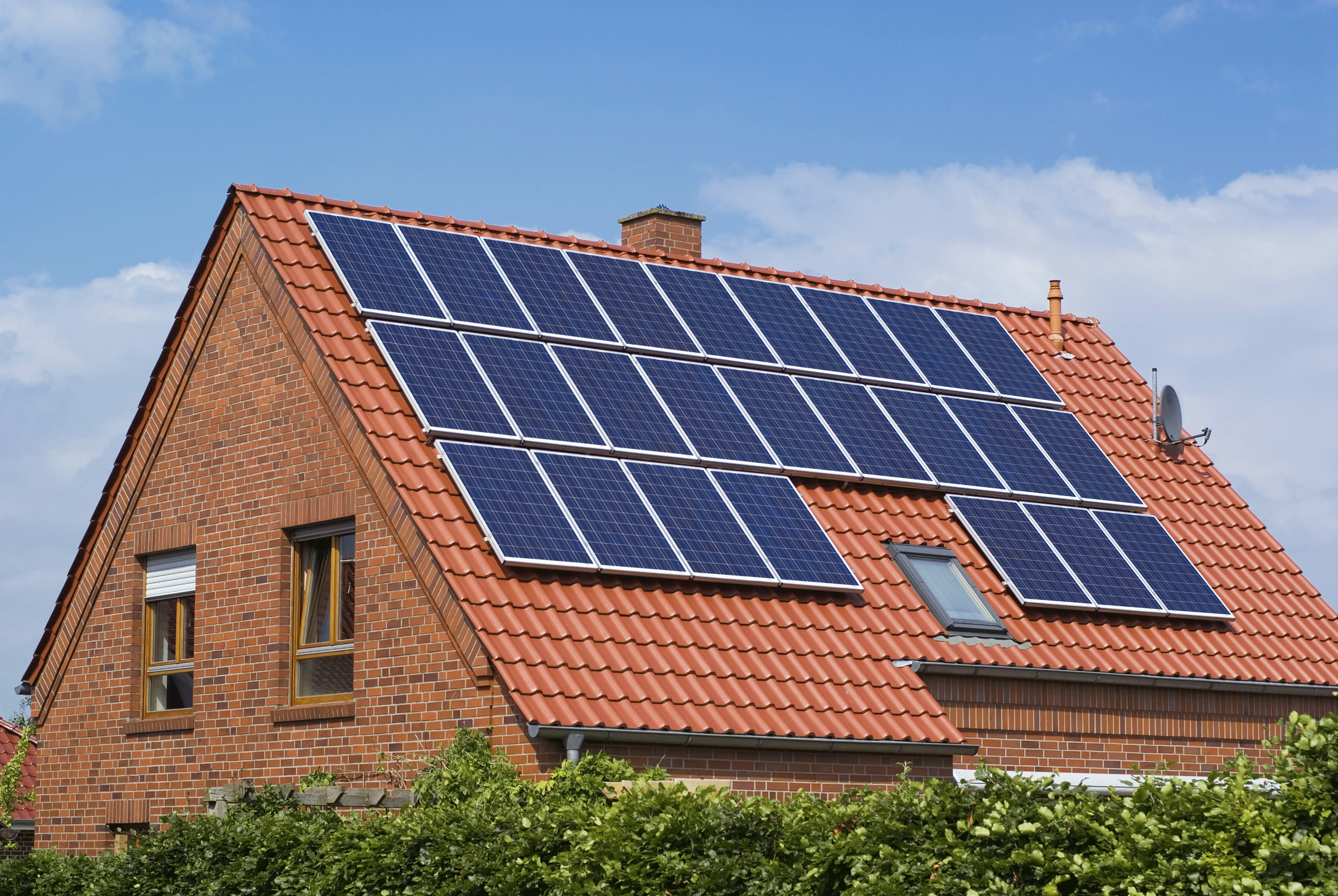
The Defense Production Act will help to make the U.S. a leading producer of renewable energy technologies in a time where markets are gravitating towards renewable energies and away from oil, gas, and fossil fuels. (Photo: birgstockphoto.com)
CURWOOD: From PRX and the Jennifer and Ted Stanley Studios at the University of Massachusetts Boston, this is Living on Earth. I’m Steve Curwood.
In February, a small solar company in California claimed China was avoiding tariffs on solar panels. So the Commerce Department started investigating shipments from several south-east Asian countries. The prospect of stiff tariff penalties immediately devastated the US solar installation business, and thousands of workers were laid off as projects were canceled or put on hold. So, Democratic Congressman Mike Levin of California led a campaign urging President Biden to take action. President Biden then placed a two-year freeze on the tariffs, and also moved to accelerate the production of domestic solar panels, as currently about 80% are imported. The Biden Defense Production Act order also boosts domestic production of other electric grid components as well as heat pumps, insulation, and hydrogen technology. For more, we are joined now by Congressman Mike Levin. Welcome to Living on Earth!
LEVIN: Thanks so much for having me, Steve, good to be with you.
CURWOOD: What are the powers of the Defense Production Act being invoked? And what limitations do you see to the impact that it can have?
LEVIN: By using the Defense Production Act, I think it will enable a rapid growth. I think what we're seeing right now, particularly with Putin's invasion of Ukraine, is the only way we're going to be truly energy independent is if we're clean energy independent. A lot of my friends and colleagues across the aisle talk about ramping up domestic supply of fossil fuels. And in the near term, perhaps that is something that will need to happen, but certainly that's not a good long term strategy. The other thing I would say is a Defense Production Act will hopefully help with the challenges of our global supply chain with regard to the solar industry, and the need to onshore manufacturing jobs as well. So I think it's one of the important tools in the toolkit. And I'm hopeful that it will be up to the task to advance a clean energy economy.
CURWOOD: How important is it that the President United States invoke the Defense Production Act to get going on the construction of solar cells in this country?
LEVIN: I think it's incredibly important. We're going to transition to a clean energy economy in the United States and around the world. And I believe the Old Wayne Gretzky quote, you know, the hockey player, where he said, skate to where the puck is going to be, not to where the puck is. And we know where the energy economy is going to be 20, 30 years from now, and it's all renewables. Global demand for solar and all the other components is set to skyrocket, some estimates have up to a 600% increase in the need for these technologies. Unless we move now to expand the technologies here at home, we risk getting priced out of clean energy technologies and having to rely on expensive foreign made components. Solar, as we know, is the largest source of new electricity being generated, and it's also the cheapest new electricity source for many parts of the country. And so I'm thrilled the President took this step. President also said he would delay any new tariffs on the American solar industry for at least the next couple of years. And ultimately, it's going to get us further along the path towards clean energy independence, where we're going to lower energy costs for families and strengthen our national security.
CURWOOD: Now, the prices for solar panels are still high for folks looking to install them on their own roofs. How soon do you expect prices to come down?
LEVIN: Well, I'm hopeful that consumers are going to see benefits in the very short term. And I know that we're now on track to deploy tens of gigawatts in the next few years, it's going to be enough to power millions more homes. And ultimately, we've got to make sure that we bring those costs down so that it's a no brainer. When you consider putting solar on the roof of your home, particularly given in many parts of the country, such as in Southern California, you've got rising electricity costs from the utilities, it really does become that much easier to make that leap. This is a step in the right direction to bring these costs down as well.
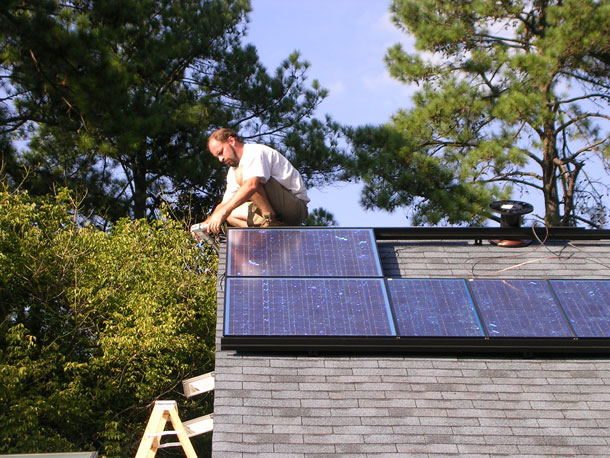
Nearly 80% of the jobs in the solar industry come from the demand-side sector, through jobs such as installation. (Photo: Melanie Bateman, Flickr CC BY-NC-ND 2.0)
CURWOOD: Now what other programs or legislation needs to be enacted or implemented for the Defense Production Act to achieve its full unintended effect?
LEVIN: Well, look, I think we have to remain committed to passing a reconciliation package that has strong climate provisions at the core. I know we're talking right now, in real time, about a few hundred billion dollars in tax incentives for clean energy. It'll help us not only meet our climate objectives, but also will help leverage these investments we're talking about that the administration is making through using the Defense Production Act.
CURWOOD: Some would say Congress is too gridlocked to get that done. Your take?
LEVIN: Well, look, I think that we're all going to be looking very closely at the climate and energy related provisions in the bill. Senator Manchin says he's committed to having provisions in the bill that would advance a clean energy future. We're gonna hold him to that. And we look forward to reviewing the bill when it's ready.
CURWOOD: What kind of pushback is the Biden administration facing for his invocation of the Defense Production Act?
LEVIN: Well, it's inevitable that the fossil fuel industry will push back on any measure to advance renewables. I would anticipate that, I'm sure there'll be more of that to come as more of those larger projects go online. But we're going to just keep going where the markets and where long term climate objectives demand. We are heading towards a much cleaner grid. And the key again, is whether or not those technologies, those companies of the future, those jobs in manufacturing, whether they're going to be here, or they're going to be elsewhere.
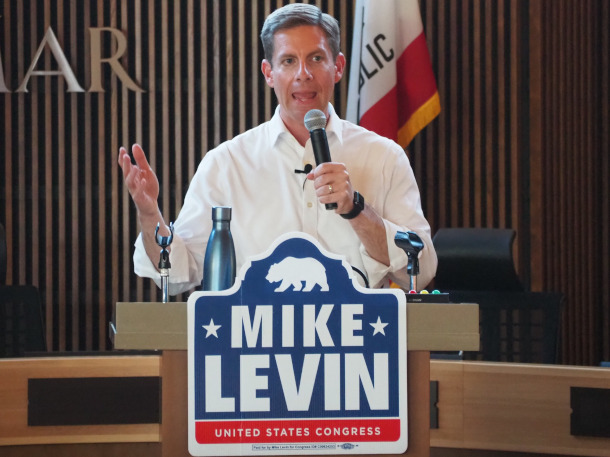
Congressman Mike Levin, long-time proponent of renewable energies, led the letter to President Biden, urging him to take action to relieve the solar industry of dire consequences wrought by the Department of Commerce’s investigation of solar panels manufactured from south-east Asian countries. (Photo: Public Domain)
CURWOOD: Some cynics suggested that the fossil fuel industry's hands were someplace in the background when it came to the imposition of a solar tariff. Your views?
LEVIN: I've wondered that myself, Steve, there are different companies that before this whole tariff fiasco, frankly, I'd never heard of that all of a sudden were saying that they represented the domestic solar industry, but when I've spoken to different companies and trade groups in the past, it was clear to me that the vast majority of our domestic solar industry, they just want to be globally competitive. And that's why I led a letter this spring urging the administration to make the common sense decision to delay any of these new tariffs.
CURWOOD: A big part of your goal as a member of Congress is to build a sustainable and renewable future, as you said many times. So how seriously do these developments like the Commerce Department investigation, or the recently decided West Virginia versus EPA case in front of Supreme Court—to what extent did they impair your ability to do so?
LEVIN: Well, I'll feel a whole lot better if we could get a reconciliation vehicle done that has robust climate investments along the order of magnitude we're discussing. But make no mistake, the extreme Supreme Court decision on the West Virginia case impeding the ability of the EPA to reduce greenhouse gas emissions, I felt was wrong, legally, and also disastrous from a policy perspective. It is unrealistic to expect Congress to write legislation that is so prescriptive as to anticipate every potential thing that could happen down the road. The Congress of the United States, with broad bipartisan support, gave the Environmental Protection Agency wide latitude under the Clean Air Act, and the Clean Water Act, and the National Endangered Species Act, and the National Environmental Policy Act. You name it, Congress has given the EPA the latitude it needs to do its job. And only now, after the disastrous decision, are we seeing winding back of the EPA's fundamental ability to do its job. And again, this was not partisan up until just a handful of years ago. So that's why again, it's so important that we try to come together around a reconciliation framework that includes a clean energy deal. And I'm certainly not going to stop until it's done.
CURWOOD: Congressman Levin, you're in your 40s. Sometimes in Congress, people are serving there in their 80s. So if we were to take a look at what the United States Congress had done, and was doing, say, 40 years from today, what do you expect to see at that time, knowing what you know now?
LEVIN: Well, I hope that we're leading the world dealing with the climate crisis with the seriousness that science demands. And I think a lot about this issue, in the context of how my own children, who are now 10 and 8 years old, are going to grow up. Are they going to grow up and know that my generation was up to the challenge when the science was so overwhelming? Or will they see a missed opportunity? Look, for all the challenges that we face, I think that we can't keep our eyes off the importance of the climate crisis. So I think it's our responsibility not to allow petty politics of the past that allow fossil fuel interests to win the day. I hope that I can look back in 30 or 40 years and know that we gave it our all to do the right thing.
CURWOOD: Congressman Mike Levin is a Democrat from California. Thanks so much, Mike, for taking the time with us.
LEVIN: Steve, thank you. It's been great to be with you.
Related links:
- Utility Dive | “Biden Invokes Defense Production Act To Boost Domestic Manufacturing in Clean Energy, Grid Sectors”
- Click here to read a letter to President Biden, from Rep. Mike Levin and other members of Congress, to expedite the solar investigation and relieve its consequences
- Rep. Mike Levin’s website
[MUSIC: Joe Ely, “Gallo del cielo” on Letter to Laredo, by Joe Ely, MCA Records]
Beyond the Headlines

As well as cutting risk of chronic illness, replacing animal protein with plant-based alternatives is the most effective way to reduce greenhouse gas emissions (Photo: Pixabay, Wikimedia Commons, public domain)
CURWOOD: So let's take a look now beyond the headlines with Peter Dykstra. Peter is an editor with Environmental Health News, that's EHN.org, and DailyClimate.org, and he's on the line now from Atlanta, Georgia. Hi, there, Peter, how are you doing and what have you got for us today?
DYKSTRA: Well, Hi, Steve. We start off with a promising story based on analysis from a major consulting organization, the Boston Consulting Group, right up there in your neighborhood in New England. They say that the best financial investment is to move to plant-based proteins. In fact, they can be a bigger factor than green building materials, electric vehicles, or the things we tend to talk about a lot.
CURWOOD: Of course, vegetable-based diets have been around for a good while, but this sort of meat substitute tasting stuff, I mean, this is a big business these days now. I walk into my supermarket and I see it in the frozen chest when I don't think I saw it two, three or four years ago.
DYKSTRA: Well, Boston Consulting says plant-based meat production has grown by a factor of five in just a few years since 2019. The report from Boston Consulting focuses on plant-based meat as an investment. And that's something that's looking absolutely golden in a green economy.
CURWOOD: I think the stuff tastes reasonably decent, but I have to admit that I've yet to find a plant-based meat substitute that really tastes like what you expect on the grill.
DYKSTRA: I've gotten a few things that are close. Personally, I've got a big and somewhat unique problem. So much of the plant-based meat production gets its protein from beans. I'm allergic to beans, but not only is fake meat a much better option than growing grass and corn to feed cattle and hogs so we can eat them, but it's better for your digestive system as well.
CURWOOD: And of course, it really reduces our risk of cardiovascular events.
DYKSTRA: That's right. I hope to find the solution for myself. Anybody that has one, let us know.
CURWOOD: To do that, write to comments@loe.org, that's comments@loe.org. And meanwhile, what else do you have for us this week?
DYKSTRA: We see constant headlines about record temperatures, drought, and wildfires in the Western US. There's a new study published in the journal Nature Communications led by researchers at the Potsdam Institute of Germany saying that European heat events are increasing in frequency. And all of this has a direct link to climate change and changing weather patterns.
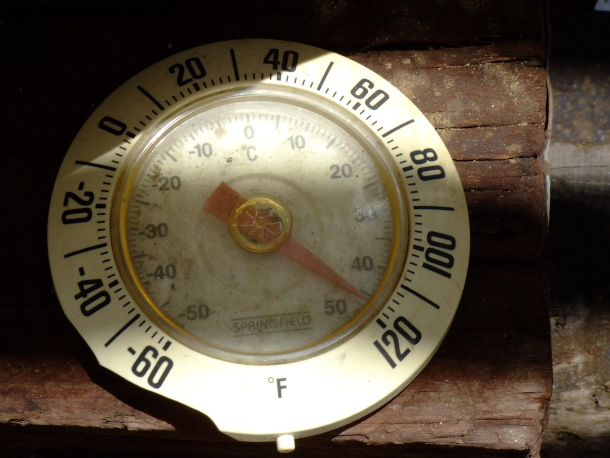
A new study has found a link between fluctuations in the jet stream and the increasing frequency of heat waves in western Europe (Photo: saturnism, Flickr, CC BY-SA 2.0)
CURWOOD: And along with Europe and the US, also in the Northern Hemisphere, we've seen a lot of trouble in Pakistan and India with record temperatures. And so, what's going on? Yeah, we know climate disruption, the planet is getting hotter. But why these places as hotspots?
DYKSTRA: A lot of it is due to changes in the jet stream, when the jet stream moves or even splits into two parts, causing heat waves with more protracted damage, including more deaths.
CURWOOD: So along with the jet stream, of course, we have a planet that's gradually getting warmer.
DYKSTRA: And it's something that is one more effect that maybe tells us we shouldn't be eating real meat.
CURWOOD: That's right. Let's take a look back now in history, Peter, what do you see?
DYKSTRA: July 16, 1946. BLM, the Bureau of Land Management, is founded to supervise and manage nearly a quarter billion acres of federally owned land in places in the western US like Nevada.
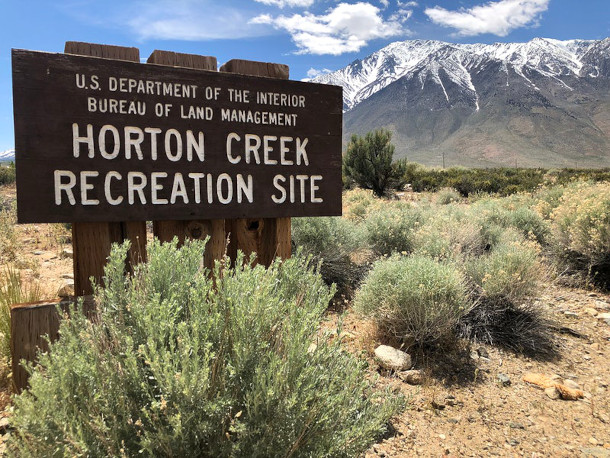
The Bureau of Land Management was established 76 years ago on July 16, 1946 (Photo: Bureau of Land Management, rawpixel, public domain)
CURWOOD: I'm not sure that the BLM is popular with some folks.
DYKSTRA: A lot of ranchers are very vocal about how BLM land is managed, loggers as well, people that operate hard rock mines and coal mines in the West.
CURWOOD: I think Native Americans aren't so wild about how genocide led to the loss of their lands, to be blunt about it.
DYKSTRA: Native Americans of course used to control all of the United States and all of Northern America. A bit of ironic justice, but BLM has lost its acronym to the Black Lives Matter movement in the last few years.
CURWOOD: A little BIPOC justice through history. Peter Dykstra is an editor with Environmental Health News, that's EHN.org, and DailyClimate.org. We'll talk to you again real soon.
DYKSTRA: Alright, Steve, thanks a lot and talk to you soon.
CURWOOD: And there's more on these stories on the Living on Earth webpage, that's LOE.org.
Related links:
- The Guardian | “Plant-Based Meat by Far the Best Climate Investment, Report Finds”
- The New York Times | “Europe is Heating Up Faster Than Other ‘Hot Spots,’ a Study Finds”
- Bureau of Land Management | History
[MUSIC: “Happy Trails To You” on Old West Saloon Piano, Vol. 1, by Dale Evans/based on Foy Willing’s “Happy Trails in the Sunshine Valley, Squeak Steele Music]
CURWOOD: Coming up – reducing the climate danger of methane from cows. Keep listening to Living on Earth.
ANNOUNCER: Support for Living on Earth comes from Sailors for the Sea and Oceana. Helping boaters race clean, sail green, and protect the seas they love. More information at sailorsforthesea.org. Support also comes from Friends of Smeagull the Seagull and Smeagull’s Guide to Wildlife. It’s all about the wildlife right next door to you! That’s Smeagull, S - M - E - A - G - U - L - L, SmeagullGuide.org.
[CUTAWAY MUSIC: Bela Fleck and Edgar Meyer, “Prelude No.24, BWV 869 from The Well-Tempered Clavier, Book 1”, on Music for Two, by J.S. Bach/arr. B.Fleck & E.Meyer, Sony Classical]
New Science Advisor Arati Prabhakar
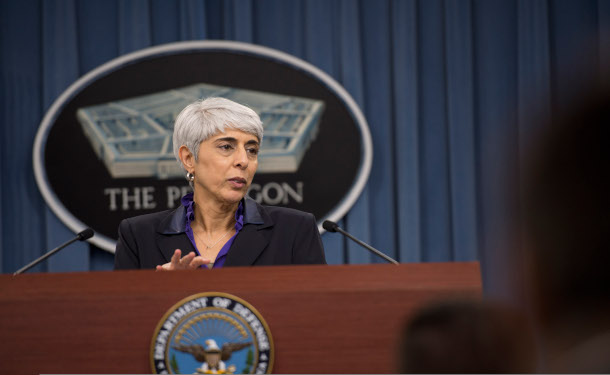
Arati Prabhakar previously served as the director of the Defense Advanced Research Projects Agency (DARPA). (Photo: Glenn Fawcett, U.S. Department of Defense, Public Domain)
CURWOOD: It’s Living on Earth, I’m Steve Curwood.
President Biden recently nominated Arati Prabhakar as White House Science Advisor, which is now a cabinet level position. Arati Prabhakar earlier served head of DARPA, the Defense Advanced Research Agency. If confirmed by the Senate, Arati Prabhakar would become the first woman, person of color, and immigrant to become Presidential Science Advisor. Seth Borenstein is a science writer at The Associated Press and he spoke with Living on Earth’s Jenni Doering about this historic nomination.
DOERING: So who is Arati Prabhakar? And what has she done previously?
BORENSTEIN: She is a veteran government science agency leader. She has lead probably the quietest and least well known science agency in the government, NIST, National Institute of Standards and Technology. And she did it at age 34, which is just amazing. 34 years old and running a government science agency. And then she came back to the government during the Obama administration and ran DARPA, which also is not as well known as places like NASA or NOAA or EPA as science agencies, but is sort of the sexiest science agency out there. They're the James Bond government agency. The internet is a DARPA invention. During her time period there, she got the agency to start looking at RNA vaccines and the technology behind that. And that was, of course, in the 20 teens. And for most of us, that was a really good idea. Because that ended up helping lead to something called the COVID vaccine.
DOERING: Yeah, I'm very grateful for her work on that.
BORENSTEIN: So she hasn't been in the big name government agencies, but she has run some of the most important. And she has a personal story that's fascinating. She came from India as a young child. Moved to Texas. She became the first woman to get a physics PhD from CalTech. And the reason she went into engineering and science is because she was told that women don't do that, girls don't do that. So she decided to do that. She's gone from the young wunderkind at NIST to literally the, you know, white haired eminence now coming in.
DOERING: So what is the role of a Presidential Science Advisor, Seth? What do they actually do?
BORENSTEIN: It's a two part job, really. One is White House Science Advisor and the second part of it is Director of the Office of Science and Technology Policy. And so that position is now a Cabinet-level position under the Biden administration; it was never a Cabinet-level position before. What this really comes down to is how much can you influence the president and his advisors. So now you have something like four or five deputy directors in the Biden White House. You have a deputy director for climate, you have a deputy director for social science, you have a deputy director for energy, you have a deputy director for health, you have a deputy director for technology. And I think there's one for, sort of, national security-ish stuff, which is strange, because this job came out of the Cold War. And until the Obama administration, it was always sort of a nuclear, Cold War-ish position. You know, it was always a physicist, it was always a white male.
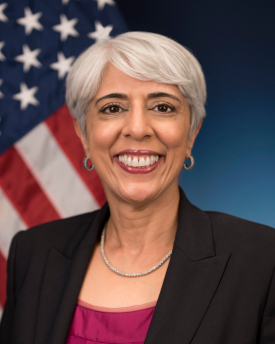
Dr. Prabhakar's official portrait as DARPA director. (Photo: Sun L. Vega, Wikimedia Commons, Public Domain)
DOERING: How significant is it, do you think, to finally have a Presidential Science Advisor nominee who is a woman, a person of color, and an immigrant? What kind of message does it send that Biden has picked Arati Prabhakar for this role after so many white men have held it?
BORENSTEIN: It shows sort of the inclusiveness that this administration made as a priority. When you talk to people about her, it's not that she's a woman, it's not that she's an immigrant, it's not that she's a person of color; it's that she's a person with an incredible amount of experience who gets things done. It's hard to imagine that there's someone who has had more experience in federal science than she has before getting this job. So, the people who do science policy just cannot praise her enough. I mean, and it isn't just the usual praise: it's real and more effusive praise. And even those who don't know her, but know of her, are just wowed by her.
DOERING: So one of the Biden administration's key priorities is climate change. So, I'm wondering how have previous Science Advisors to presidents advanced or influenced the administration's agenda on climate?
BORENSTEIN: Climate was not high up on the priorities until the Obama administration. The Obama White House Science Advisor John Holdren was a climate scientist. So, that was a first. And then, when Trump finally named a science advisor, he named a meteorologist, which was really surprising. And Kelvin Droegemeier, who has one of the best names for a meteorologist, Kelvin, which is one of the three ways you measure temperature: Kelvin, Celsius and Fahrenheit, gotta give him credit, that was the second straight climate, meteorology White House Science Adviser. Of course, the idea was keeping your head down. Doing the work but not having the White House pay attention because President Trump was an out and out climate change denier. I mean he'd talk about it and tweet about it.

A portrait of Arati Prabhakar taken before her nomination as the White House Science Advisor and the Director of the Office of Science and Technology Policy. (Photo: Christopher Michel, Flickr, CC BY 2.0)
DOERING: So how fair is it to say that she'll be joining a team within the White House that is already pretty focused on climate? And that she'll be helping to support that?
BORENSTEIN: Yeah, that's exactly what, she's, there is a crowded team of experts on, focused on climate change in this White House. And I think had the president named someone who was another climate change scientist to that position, that actually in some ways could dilute it because it's another person. So, her job isn't there to be the climate voice. You know, Biden has lots of climate voices.
DOERING: That's really heartening. And it seems vital. I mean, she won't be working only on climate issues, of course, but climate is one of the most important science issues that we face currently. And I guess I'm wondering, where do you think the president's agenda on science stands now? Especially, given how his climate legislation has gotten bogged down in Congress and now the U.S. Supreme Court has sent a really clear signal to agencies like the Environmental Protection Agency limiting their authority.
BORENSTEIN: So this administration is sort of the innovator. And then that comes back to: here's a woman who, this is her job. This is what she does. Now she does, it's not climate that she does. But whether it is like the James Bond DARPA, and wow, what can we do that's really cool and thinking out of the box. Or, it's something like in NIST, where, where can just a tiny little change, that's not really noticeable, but then when you turn around 10 years later you say, oh my, that made a big difference. So, she's coming from, with that experience. I'm not saying it'll work. But that's what they have to look for right now.
DOERING: I wish her the best of luck in this role. And we'll have to see, in terms of confirmation and what the Senate says here. Do we have a sense of the timing on that?
BORENSTEIN: Not yet. There's been an awful lot of other stuff going on in Congress.
DOERING: Really? I didn't know.
BORENSTEIN: You know, when she was first nominated to NIST 30 years ago, she flew through unanimously. Different time, it's hard to say that will, that'll happen again. And sometimes these positions get held up, a Senator can put an appointment like this on hold. But it's not like when there was this vast, long opening during the Trump administration. It was sort of adrift. The White House Science Office is not adrift right now.
CURWOOD: That’s Seth Borenstein, science writer for the Associated Press, speaking with Living on Earth’s Jenni Doering.
Related links:
- Learn more about NIST – National Institute of Standards and Technology
- Learn more about DARPA – Defense Advanced Research Projects Agency
- Learn more about Dr. Arati Prabhaker
[MUSIC: Erroll Garner, “Misty” on Gemini on Mack Avenue, by Erroll Garner, MAC Records]
Feeding Seaweed to Cows for Lower Emissions
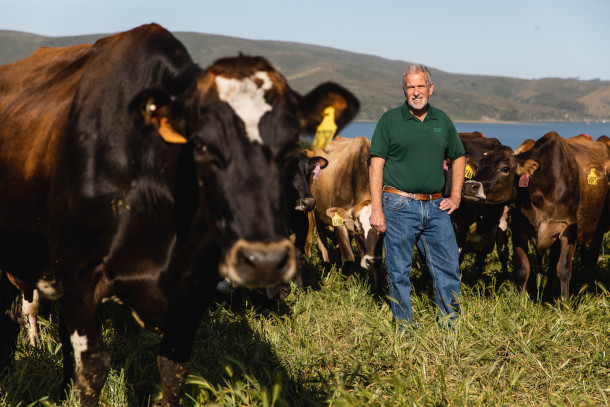
Methane from animal agriculture contributes 36% of the United States’ annual methane emissions. Albert Straus enrolled his cows in a seaweed-supplement trial that saw average methane reductions of 52% per cow. (Photo: Courtesy of Straus Family Creamery)
CURWOOD: In the U.S., more than a third of our methane emissions come from livestock, mostly from cattle. Methane is short lived in our atmosphere, lasting only about a decade, but it is roughly 85 times more potent than carbon dioxide as a greenhouse gas when it’s first emitted. For years, a few farms have reduced methane emissions from manure with methane digesters, which process the dung into green energy. And now scientists and dairy operators are trying out ways to limit methane from the other end, the bovine belches. It turns out that feeding cows a small amount of seaweed can help dramatically. For more, Living on Earth’s Bobby Bascomb spoke with Albert Straus, Founder and CEO of Straus Family Creamery in Marshall, California, who says seaweed holds great promise for his small enterprise.
STRAUS: We've been trying to sustain small scale family farms. In the United States in 1940, we had 4.6 million dairy farms. Today, we have under 30,000 dairy farms left and they only expect 20,000 to survive next decade. Our average dairy is 250 cows, whereas nationally, I think it's probably 1000s of cows now. And so it's better for the soil, air quality, water quality, and the planet to have small scale dairy farms. So you have local food systems rather than national or international food systems.
BASCOMB: Now, I understand that you recently participated in a USDA approved trial with Blue Ocean Barns where you tested incorporating a small amount of seaweed into the diet for your cows.
STRAUS: Yes. So four years ago, we saw in the newspaper an article that they were testing this one specific variety of red seaweed in Australia and Canada. And when we found out that UC Davis was gonna be doing trials on it, we collaborated with them with the intention of being the first commercial trial. So Blue Ocean Barns evolved out of that UC Davis trial. It's a for-profit that's growing this specific variety of red seaweed in Hawaii - in tanks so that it's not depleting our oceans - and it will be certified organic, so that we can use it on our farm and all the farms that are certified organic in our area. Last summer, we concluded our trial, it was the longest and largest trial that had been performed in the United States and perhaps the world.
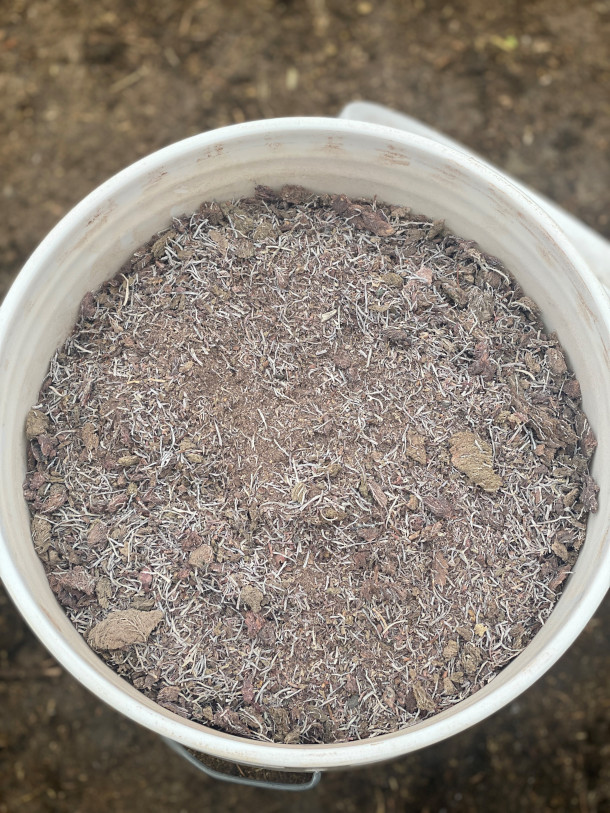
Blue Ocean Barns supplied the seaweed for the first commercial trial. They grow seaweed in tanks in Hawaii in order to not deplete ocean ecosystems. (Photo: Courtesy of Straus Family Creamery)
BASCOMB: Can you tell us more about that? Why seaweed? And how is it actually supposed to help with the methane that cows released from belching?
STRAUS: This specific variety of red seaweed has a chemical called bromoform that reacts with the bacteria in the stomach of the cow, the rumen of the cow. Instead of the bacteria giving off methane, they give off hydrogen. And it also has some benefits of making the cows more efficient on how much feed they have to eat versus how much milk they produce.
BASCOMB: And it's healthy enough for the cows, it's not damaging to them in any way?
STRAUS: No, the tests show that there was no ill effects on the cows.
BASCOMB: So you mentioned it's grown in tanks so it's not depleting the ocean of its seaweed resources. And I understand that it's also dried before you give it to the cows. How did the cows like it? Do they seem to eat it readily?
STRAUS: Yes, I think the original trial took a little bit of time to get it situated properly. But yeah, the cows took to it. We're looking at how we can make it palatable and something that we can deliver in different feeding systems to cows. So that's what we're gonna be working on this year.
BASCOMB: So what were the results of your trial feeding seaweed your cows?
STRAUS: There were 24 cows under a treatment group, 24 cows in a control group, it went for 50 days, and by feeding one quarter pound in our 45 pound ration, we were able to get a 52% average reduction in methane emissions with a couple cows over 85% and one at 92% reduction. So it was a very successful trial. There was no residuals of any chemicals. And the state of California subsequently approved the use of it as a feed supplement.
BASCOMB: How do you measure the methane emissions coming out of an individual cow? I'm imagining, you know, like a mask or something on Bessie. How did you manage that?
STRAUS: They're called green feeds, they're a machine where the cows go into a stall two to three times a day, they're incentivized with a little bit of grain, and it measures the emissions coming from the belches from the cows and analyzes it on site. And then it was transmitted to the Cloud where the researchers could collect the data and compile it.
BASCOMB: And what about the milk from these seaweed-fed cows? How does it taste? Can you tell any difference?
STRAUS: That was one concern of mine, was that if the milk didn't taste good, or you know, very similar to the milk that we produce, it was gonna be a non-starter. And we did a blind taste test with our staff at the Creamery and there was no difference in the taste of the milk. So we were very pleased by that.
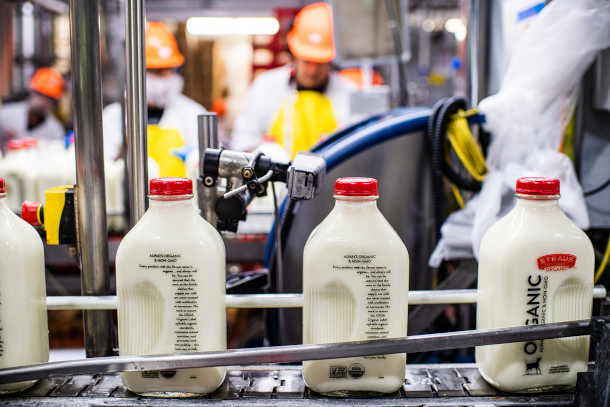
The milk from seaweed-fed cows tasted no different from that of regular-feed cows when tried in a blind taste test. (Photo: Courtesy of Straus Family Creamery)
BASCOMB: So you know, in the US alone, we have on the scale of 94 million cows to feed. How realistic is it, do you think, to scale up production of seaweed for all those cows?
STRAUS: I think we'll have enough in the next couple of years to feed all our cows on our farm. And I think the goal is to have enough to feed 50 to 100,000 cows just from this one company Blue Ocean Barns. As it scales, and as we put priority and resources against it, we will meet those needs.
BASCOMB: Well, you know, we've known about this problem of methane from cows for quite a long time now. And another solution that people have looked into is methane digesters. We've been talking here about methane from belching, which the seaweed is supposed to address, but the manure also contains quite a lot of methane. The idea behind a digester is that you heat it to a very high temperature and it makes electricity, basically. I understand that you've already invested in methane digesters on your farm. How's that working out for you?
STRAUS: We installed the digester 18 years ago, and we've been producing all the electricity for our farm for the last 18 years, and we are selling our carbon credits to the market and creating an alternative income source. So we're taking a greenhouse gas out of the atmosphere that's 84 times more detrimental than carbon dioxide and creating a resource. It's not only beneficial to the environment, it's beneficial economically for farms as well.
BASCOMB: Well, that's the thing, you know, how do the economics work out? Especially if a farmer is listening to this and maybe wants to try something along these lines, I would think there's got to be a pretty big startup cost. How did you manage that? And what do you see as the return on the investment, you know, how long did it take for you to start breaking even or even making money from this?
STRAUS: Originally, the cost was about $350,000, of which we got $140,000 of grant money. And we're offsetting 40 to $50,000 a year in energy costs, electric costs, so it had a four to five year payback. Likewise, we've just done a trial on a small scale digester for small scale dairy farms that will have less than a five year payback, use a revolving fund rather than having farmers go into debt, and have a company build and operate these digesters so the farm doesn't have to take their resources and labor.
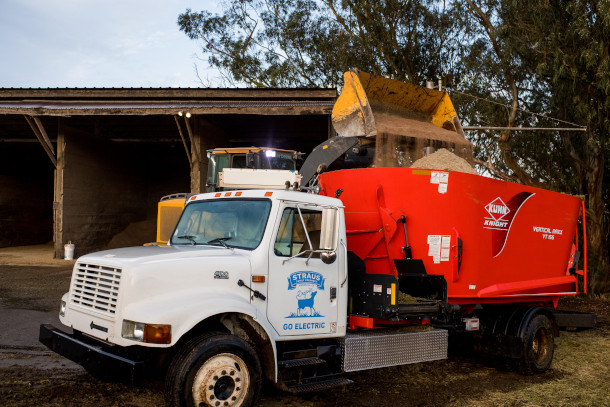
Methane digesters turn the methane in cow manure into electricity. Straus Family Creamery uses this electricity to power their fleet of vehicles. (Photo: Courtesy of Straus Family Creamery)
BASCOMB: You know, a lot of people are looking to reduce their consumption of dairy and meat as a way to reduce personal greenhouse gas emissions. As a farmer, what is your take on that? Are animal products and climate solutions mutually exclusive?
STRAUS: For me, my belief is that animals have an essential role in reversing climate change. I've been all around the world supporting small scale farmers and animals are part of a farming system, in balance with plant based food as well, but it's a balance, it's not an extreme. So I think it's how do you make a farming system that balances these different environmental needs as well as producing healthy food for local consumers? Bringing plant based foods from around the world is not good for the environment either. And the United States, we're importing half our fruit, a third of our vegetables, 80% of our lamb, 90% of our seafood, 11% of our beef, it's not sustainable for our local communities or our planet.
BASCOMB: Albert Straus is the founder and CEO of Straus Family Creamery in Marshall, California. Albert, thanks so much for your time today.
STRAUS: Thank you for allowing me to be on this show.
Related links:
- Learn more about Straus Family Creamery
- Learn more about Blue Ocean Barns
[MUSIC: Rufus Thomas, “Old MacDonald Had a Farm, Part 2” on Sing Along With Putumayo, Traditional/arr. by Rufus Thomas, Putumayo Records]
CURWOOD: Coming up – a weather guru on wild weather around the world and at Yellowstone National Park. That’s just ahead on Living on Earth.
ANNOUNCER: Funding for Living on Earth comes from you, our listeners, and United Technologies, combining passion for science with engineering to create solutions designed for sustainability in aerospace, building industries, and food refrigeration.
[CUTAWAY MUSIC: Mongo Santamaria, “Bonita” on Afro Blue, by Mongo Santamaria, Concord Records]
BirdNote®: Brewer’s Sparrow, Sageland Singer
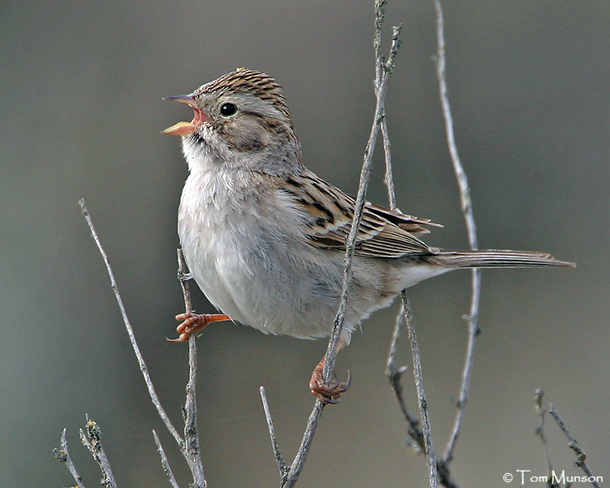
A Brewer’s Sparrow sings lustily in the American West. (Photo: © Tom Munson)
CURWOOD: It’s Living on Earth, I’m Steve Curwood.
[BIRDNOTE THEME]
CURWOOD: In the wide-open spaces of the American West, a dusky brown bird holds forth with an impressive song. BirdNote®’s Mary McCann has more about the sage land singer called the Brewer’s Sparrow.
BirdNote®
Brewer's Sparrow, Sageland Singer
[Long song of the Brewer’s Sparrow]
Every spring, one of the most musical and complex bird songs on the continent rings forth from the sagebrush of the Columbia Basin in Washington State.
The Brewer’s Sparrow, a migratory songbird that winters mostly in western Mexico, returns in April to the sage. Sagebrush habitat, often called shrub-steppe, is a common landscape of the interior West. However, each year more and more of it is being cleared for irrigated crops and development.
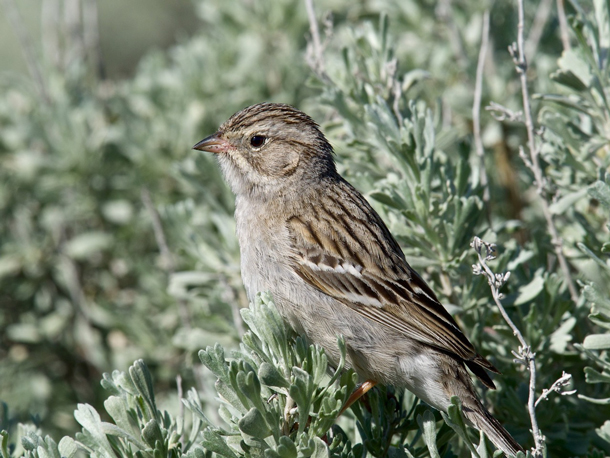
Brewer’s Sparrows thrive in sagebrush habitats. (Photo: © Gregg Thompson)
The diminutive Brewer’s Sparrow shares its nesting habitat with other fancy singers like the long-winded Sage Thrasher and the melodic Vesper Sparrow. All three of these birds are sandy brown in color, blending so seamlessly with their surroundings that only a sharp eye can pick them out. Yet even among this accomplished company, the Brewer’s song stands apart. While most birds offer a melody, the Brewer’s Sparrow seems to perform an entire aria.
I’m Mary McCann.
[Song of the Brewer’s Sparrow]
CURWOOD: For pictures, fly on over to our website, loe.org.
Related links:
- Learn more on the BirdNote® website
- More information at BirdWeb.org
###
Written by Bob Sundstrom
Song of the Brewer’s Sparrow provided by The Macaulay Library of Natural Sounds at the Cornell Lab of Ornithology, Ithaca, New York. Recorded by G.A. Keller.
BirdNote’s theme was composed and played by Nancy Rumbel and John Kessler.
Producer: John Kessler; Managing Producer: Jason Saul; Editor: Ashley Ahearn; Associate Producer: Ellen Blackstone; Assistant Producer: Mark Bramhill.
© 2019 Tune In to Nature.org June 2012/2019 Narrator: Mary McCann
ID# 060705BRSP BRSP-01b
https://www.birdnote.org/show/brewers-sparrow-sageland-singer
[MUSIC: Jacob Collier, “Hideaway” on In My Room]
Grand Teton and Wild Weather Out West
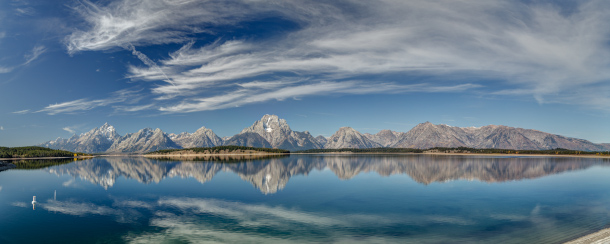
Jackson Lake pictured above, a remnant of glacial gouging from the Teton Range to the west and the Yellowstone Plateau to the north. It was enlarged by the construction of the Jackson Lake Dam. (Photo: Tim Lumley, Flickr, CC BY-NC-ND 2.0)
CURWOOD: During the summer, many folks head out on vacation to the national parks, and from time to time we like to bring you stories about some of those places. Well, when we looked into Grand Teton National Park in Wyoming, we ran into an unusual park volunteer, David Titley. Retired Rear Admiral David Titley founded the Climate Change Task Force for the US Navy and later served as Chief Operating Officer for the National Oceanic and Atmospheric Administration, NOAA. Admiral Titley now spends summers with his wife in an Airstream trailer at Grand Teton simply ’helping out,’ as he likes to say. And so when we called him up to ask about the park, we couldn’t help asking him about some of recent extreme weather events related to climate change, from around the world to nearby Yellowstone National Park. In June, record rains and flash floods forced Yellowstone to shut down for a while, and the entire West is concerned yet again about wildfires, including those this year in Yosemite that have threatened the Giant Sequoias. So when we reached Admiral Titley in his camper at Grand Teton National Park we just couldn’t resist talking about the weather, at first. Welcome to Living on Earth!
TITLEY: Well, thank you, Steve. Thanks so much for having me.
CURWOOD: Let's talk in a broad sense, what's happening to the world's weather in response to climate disruption? I mean, you are, at one point you were the Navy's top weather person, if I can put it that way. And right now we're looking at what, heat waves in Europe, kind of off the scale. We saw some in India, not so long ago that were way off the scale. Fires seem to be going more and more in the American West. What's going on? And you know, somebody who's been looking at climate disruption and weather for much of your career, give us a status report on where we are.
TITLEY: Well, Steve, it's tragically, and I hate to say it, but this is basically, what scientists have been telling the world to anyone who would listen for at least 30, 40 years, and we are seeing this come to fruition. And you know, many times, as I'm sure you know, when you have a climatologist or a scientist come on to the media and talk about sort of the bad things and how extreme the weather is going to get, many times people say, ‘Oh my goodness, you're an alarmist, and it's really not gonna be that bad.’ I would say, if anything, the science community has probably underestimated the speed and the intensity of the extreme events. And the really, to me, kind of scary thing is the world is not yet even at 1.5 degrees Celsius as an average above the pre-industrial limits. And our chances of, of holding to 1.5, you know, between you and me are, are very, very slim, I mean, we're just not seeing the change coming at the pace that we need. So if we're going to two or even three degrees Celsius global warming before we finally get this under control, as bad as 2020, 2021, 2022 have seemed, these will be the good old days. These will be when the weather was calm by comparison. And, again, I'm not trying to scare anyone, I'm not trying to alarm anyone, but those are just the facts. And this is just really basic physics. Physics we have understood for nearly 200 years now. And it's coming to fruition. And as I said, if anything, we have underestimated the speed and the intensity of these extreme events.
I mean………#GrandTeton #theTetons #Wyoming #moose #goldenhour #hillbillyviking @GrandTetonNPS pic.twitter.com/LGBQF8HBCP
— hillbillyviking (@mac_cheeves) July 13, 2022
CURWOOD: And as a Navy veteran, what have you noticed particularly happening in the Navy is perhaps a function of climate disruption?
TITLEY: So, the Navy really has to look at, in my opinion, three things. They have to look at how climate is going to impact their operations. They have to look at how climate is going to impact their bases and their training ranges. I like to say that, you know, the Navy is almost by definition at sea level. We are not like some of the other services that can just move to the middle of the country and say, well okay, that's our mitigation strategy. We, we have to be at sea level, the U.S. Navy has to be at sea level. And then finally, and this is maybe the most complex one, that I'm pleased to see the U.S. intelligence community really, really starting to get serious about is: how is climate change going to exacerbate maybe already unstable situations and not great situations, but it's not great, but the U.S. maybe doesn't have to do a lot, but it sort of tips it over. And for those listeners who sort of remember the old BASF commercial, ‘we don't make things, we make things better,’ climate is what I like to say is the anti-BASF, it's like ‘we don't make things, but we make things worse.’ So what situations, you know, due to whether it's demographics or political or religious differences, I mean, the world's always had those, right? But now you add climate change pushing especially on migration, on inequality, on food security, and that just exacerbates or inflames these already existing tensions. And it can just push this into a very dark place.
CURWOOD: By the way, I think you're aware of an equipment incident related to climate disruption in the Mediterranean recently.
TITLEY: So, this is very recent and not to sound mealy mouthed, but we really, all I know is what I've read in the media, here is, but apparently an aircraft was blown off of an aircraft carrier. You know, one of our frontline fighter aircrafts was blown off of an aircraft carrier, at least according to media reports in outlets such as the Washington Post. The U.S. Navy says the incident is under investigation, but it will be very interesting to first let the investigation run and find out what actually happened there. But if there's a weather connection, the next step will be to see okay, is this just a really freak event or is there some type of climate link to that weather? Because normally, in the Mediterranean, and I've deployed there a number of times when I was in the Navy, in July, August, June, it's a pretty benign environment. So clearly this wasn't benign.
CURWOOD: And I guess the suspicion of climate interaction is there because we're seeing record heat waves now in Spain, Portugal. Italy is worried about running out of water to run its hydroelectric power stations. So, there's a lot going on with intense weather in Europe.
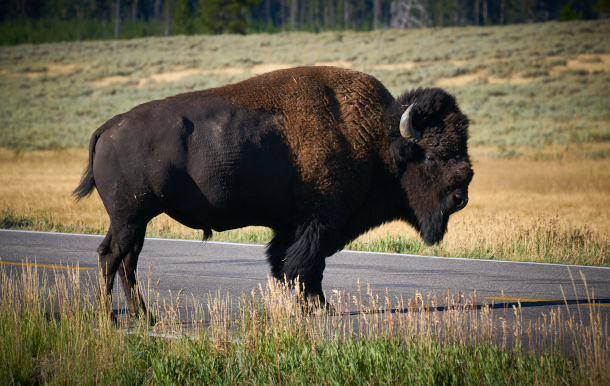
Grand Teton National Park is home to a variety of animals including black bears, grizzly, moose, elk and bison (pictured above). (Photo: Pedro Szekely, Flickr, CC BY-SA 2.0)
TITLEY: Absolutely. And, and as I said, if the sobering part about this is as bad as this is, 2022 will rapidly become the good old days.
CURWOOD: Talk to me a bit anecdotally about some of the extreme events that have caught your eye recently.
TITLEY: Well, one, of course, that happened only 100, 150 miles to my north was this massive flooding we had in the Yellowstone River, along the northern edge of Yellowstone National Park back in June. And it's what I call these rain bombs, these very, very intense rainfall events usually happening in a matter of hours, oftentimes on pretty small scales. So what I mean by that is just, you know, maybe over 10 square miles, maybe 50 square miles, not, not a huge geographic extent. This particular event fell on a pretty deep snowpack. It turns out in the Northern Rockies we've actually had a relatively cool, relatively wet spring. So, the snow that fell over the winter, plus some even in the spring was still on the ground at high elevations. And now we put three, four, even five inches of rain in just a matter of hours, overnight, on top of this snowpack. So you have melting snow, huge amounts of rain, all coming down into these narrow canyons in the Yellowstone River. And we've all seen the video, we've seen the video of how the roads washed out. What we didn't see quite as much is U.S. Park Rangers losing their houses, losing all their possessions. Water, power, sewer infrastructure just being washed away. It was, to me, just devastating. And it's the only thing that really compares to that as far as intensity is the speed with which Yellowstone has managed to mostly recover and actually reopen 93% of their park to the visitors. When I saw those videos, I figured there's no way they're opening up the northern part of the park this summer. And sure enough, in three weeks, they did, so, you know, kudos to everybody who's done that with the leadership of Cam Sholly and many, many others at the state, federal and local level. But, that's one that's in my mind, simply because it was only about 100 miles away from where I'm living this summer.
CURWOOD: So, the recent flooding at Yellowstone, how did that affect Grand Teton? And in general, what's going on with the climate in the Greater Yellowstone Area?
TITLEY: So, to your first question, really, we were in a supporting role. The physical infrastructure here in Grand Teton was absolutely not damaged in any ways. We did not have those extreme rainfalls, while Yellowstone, the northern part of their park was picking up three to five inches that night, we had maybe an inch or so. So, our streams and our rivers came up to, let's say, bank full, but I'm not aware of any flooding. What we did have was a whole lot of temporary refugees, when Yellowstone had to rapidly close their park and evacuate all their visitors for safety reasons. Many of those visitors came down south into Grand Teton Park. So, we had to work with the town of Jackson and others and figure out you know, really, how can you help these, these visitors out. So, many people did a lot of great things. The town of Jackson opened up their fairgrounds so that you could camp there overnight for a couple of nights until people could make other arrangements and basically move on from there.
CURWOOD: By the way, I want to just pause for a moment and ask you to describe Grand Teton National Park. Yellowstone is, is iconic, I mean, there's even a cartoon series based on it, right? I think that they call it Jellystone with a Yogi Bear or something. But, Grand Teton, in the same neighborhood, is less well known. Describe for me what's at Grand Teton and both what attracts you as a volunteer there and what attracts visitors?
Epic #flooding on the Yellowstone River has wreaked havoc on #yellowstonenationalpark and #gardiner This NPS housing unit was the latest victim of the relentless #flood a little while ago. #yellowstoneflood #Montana #montanaflooding pic.twitter.com/vNJxhqEjHJ
— Michelle Holihan (@mtnmichelle) June 14, 2022
TITLEY: Sure, I think Grand Teton, as you mentioned, Steve is maybe not quite as well known as Yellowstone. Although if you're coming up from the south through Yellowstone, you're going to come here. I think one of the defining characteristics of this valley is we have really these iconic mountains. And it turns out that they are formed as much because the valley floor has actually dropped as much as the mountains have increased. So we have this really flat floor. And then you go from about 6,000 feet to nearly 13,000 feet pretty much straight up. So, although they're not even the highest peaks in Wyoming, let alone in the Rockies, Colorado has, of course, a very famous 14,000 foot peaks, our mountains sort of have that almost, you know, if anybody asks, even in elementary school draw the Rocky Mountains, that's what the Tetons look like, starting from this flat valley and then just this very iconic lifting. So, this produces all kinds of recreational opportunities for hiking, skiing, cross country skiing in the winter, climbing. We have many, in fact, maybe all of the same wildlife that Yellowstone has. So we have bears, we have bison, we have elk, we have sort of all these large, large animals, as well as many of the smaller ones. We have wolves here. So there's wildlife viewing. The town of Jackson is really iconic in its own right, so there's tremendous infrastructure and services for visitors. You can raft on the Snake River, so we have water, water use and we have fishing. So it's really, you know, nirvana, if you will, for recreation. We have wide open spaces, we have these various flats, we call them, that are really just sagebrush and that gives great views. And it also lets visitors, when we have animals out on those flats, be able to see those animals as opposed to some of the other parks where you have so many trees, you don't always get those kinds of views. So, this particular park has, has attracted my wife and myself for decades. And we just find it to really be therapeutic, if you will, to be out and hiking in these mountains on, on the trails here. It just never gets old to us.
CURWOOD: I like it that you can see the bears at a distance. And for that matter, it's great to be able to see the bison gathered in, in herds, again, without getting too close.
TITLEY: Exactly. And we all know the park has regulations on how close people should be to the animals and that we're not disturbing their behavior. But those opportunities exist in, in this park. And frankly, you know, quite a few of the other Western parks as well.
CURWOOD: David Titley, you, you can tell us, what's your favorite day hike there at Grand Teton?
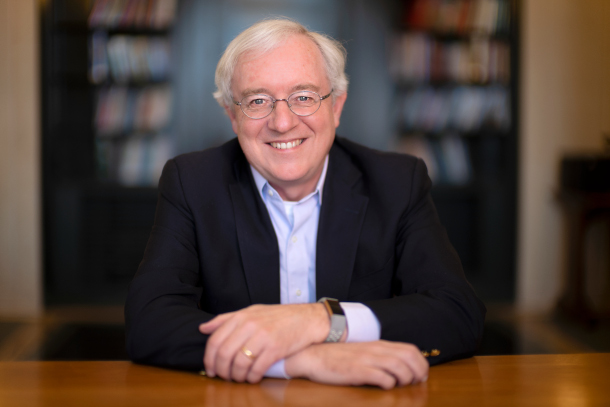
David William Titley is a professor of meteorology at Pennsylvania State University and the founding director of their Center for Solutions to Weather and Climate Risk. He was also NOAA's chief operating officer from 2012 to 2013. (Photo: Christopher Michel, Flickr, CC BY 2.0)
TITLEY: There are so many, right, this is like asking which, which of your childs are the, are the favorite there. So, there are really iconic hikes here around Jenny Lake, maybe the most visited place in the park or one of the most visited for sure. And you can go up to Inspiration Point and, and we have many, many visitors who go up to Inspiration Point, it's maybe a mile on the what we call the west side, going up into the mountains. And it's a wonderful hike. But a lot of visitors kind of stop at Inspiration Point. They made it, they gained the roughly 1,000 feet elevation, take their pictures of Jenny Lake in the valley and then they come down. If you keep going into that canyon, it's called Cascade Canyon. I tell people it looks like Switzerland on steroids. I think it's one of the most gorgeous places and it's, you're not going to have it by yourself. It's still a pretty popular hike. But it's just absolutely gorgeous. And you can walk and you've done most of the elevation. After Inspiration Point, it really flattens out. So you can maybe go another three, three and a half miles until the trail really starts going up again. And if you're lucky, you might see a moose, you might see a bear, you might see a fox. You're definitely gonna see just eye dropping scenery of mountains and canyons. So, that's a, that's a great hike. But we have so many hikes in this park. So, really you can't go wrong and I would just ask somebody you know, check with a, check with a ranger, check at the Visitor Center. Tell that ranger what you're looking for, and he or she is going to give you some great options.
CURWOOD: Retired Admiral David Titley is the founder of the U.S. Navy Task Force on Climate Change and former Chief Operating Officer for NOAA, and now spends his summers as a volunteer in Grand Teton National Park. David Titley, thanks so much for taking the time with us today.
TITLEY: Well, thank you, Steve. It's been a pleasure. I appreciate you having me on.
Related links:
- Learn more about Grand Teton National Park
- Watch David Titley’s Ted Talk
- National Geographic | “Historic Yellowstone Flooding Brings Renewal Despite Destruction”
- Learn more about the Greater Yellowstone Climate Assessment
- The Washington Post | “Nasty Weather Blew a Jet Off an Aircraft Carrier. How’s That Possible?”
[MUSIC: Leonard Bernstein/New York Philharmonic Orchestra, “Grand Canyon Suite: III. On the Trail,” on Leonard Bernstein - Remastered, Disc 10, by Ferde Grofe, Sony Classical]
CURWOOD: Living on Earth is produced by the World Media Foundation.
Our crew includes Naomi Arenberg, Bobby Bascomb, Paloma Beltran, Chloe Chen, Iris Chen, Josh Croom, Jenni Doering, Delaney Dryfoos, Mark Kausch, Mark Seth Lender, Don Lyman, Louis Mallison, Aynsley O’Neill, Sophia Pandelidis, Jake Rego, Hannah Richter, and Jolanda Omari. Tom Tiger engineered our show. Alison Lirish Dean composed our themes. You can hear us anytime at L-O-E dot org, Apple Podcasts, and Google Podcasts, and like us, please, on our Facebook page - Living on Earth. We tweet from @livingonearth. And find us on Instagram at livingonearthradio. I’m Steve Curwood. Thanks for listening!
ANNOUNCER: Funding for Living on Earth comes from you, our listeners, and from the University of Massachusetts, Boston, in association with its School for the Environment, developing the next generation of environmental leaders. And from the Grantham Foundation for the protection of the environment, supporting strategic communications and collaboration in solving the world’s most pressing environmental problems.
ANNOUNCER 2: PRX.
Living on Earth wants to hear from you!
Living on Earth
62 Calef Highway, Suite 212
Lee, NH 03861
Telephone: 617-287-4121
E-mail: comments@loe.org
Newsletter [Click here]
Donate to Living on Earth!
Living on Earth is an independent media program and relies entirely on contributions from listeners and institutions supporting public service. Please donate now to preserve an independent environmental voice.
NewsletterLiving on Earth offers a weekly delivery of the show's rundown to your mailbox. Sign up for our newsletter today!
 Sailors For The Sea: Be the change you want to sea.
Sailors For The Sea: Be the change you want to sea.
 The Grantham Foundation for the Protection of the Environment: Committed to protecting and improving the health of the global environment.
The Grantham Foundation for the Protection of the Environment: Committed to protecting and improving the health of the global environment.
 Contribute to Living on Earth and receive, as our gift to you, an archival print of one of Mark Seth Lender's extraordinary wildlife photographs. Follow the link to see Mark's current collection of photographs.
Contribute to Living on Earth and receive, as our gift to you, an archival print of one of Mark Seth Lender's extraordinary wildlife photographs. Follow the link to see Mark's current collection of photographs.
 Buy a signed copy of Mark Seth Lender's book Smeagull the Seagull & support Living on Earth
Buy a signed copy of Mark Seth Lender's book Smeagull the Seagull & support Living on Earth

